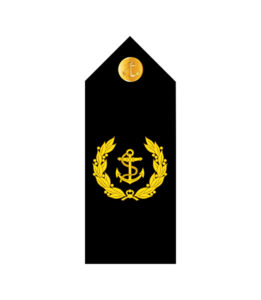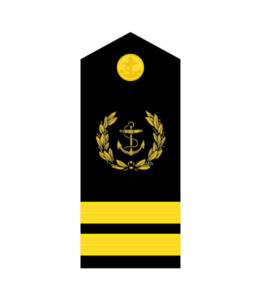Indian Navy Ranks and Insignia: A Complete Guide
Have you ever wondered how the ranks in the Indian Navy are structured? Do you know about the highest rank in the Indian Navy that has never been awarded to anyone?
If not, then stay with us till the end of this blog, where we will uncover all the important details about the Indian Navy's ranks and insignia.
Now, let's get started! 🚢⚓
A Brief History of the Indian Navy
The Indian Navy has a rich and ancient history, but its modern structure can be traced back to the British era.
- In 1612, the British East India Company formed a small naval force to protect its trade routes from Portuguese and pirate attacks.
- Over time, this force evolved, and in 1830, it was renamed the Her Majesty’s Indian Navy.
- After India's independence, the name "Royal Indian Navy" was changed to "Indian Navy" on 26 January 1950, when India became a republic.
Today, the Indian Navy is one of the most powerful naval forces in the world, safeguarding India's maritime interests.
Indian Navy Ranks and Insignia
The Indian Navy ranks are categorized into:
1️⃣ Commissioned Officers
2️⃣ Junior Commissioned Officers (JCOs)
3️⃣ Non-Commissioned Officers (NCOs)
1. Non-Commissioned Ranks (Sailors)
These ranks consist of sailors who serve under the commissioned officers.
1️⃣ Seaman Second Class (SMN II)
- Lowest rank in the Indian Navy.
- No insignia or badge.
2️⃣ Seaman First Class (SMN I)
- Senior to Seaman Second Class.
- No insignia or badge.
3️⃣ Leading Seaman (LS)
- Senior to Seaman First Class, but junior to Petty Officer.
- Insignia: One anchor symbol.
4️⃣ Petty Officer (PO)
- Senior to Leading Seaman.
- Insignia: Two crossed anchors + Ashoka emblem.
5️⃣ Chief Petty Officer (CPO)
- Senior to Petty Officer.
- Insignia: Golden anchor surrounded by laurel leaves.
6️⃣ Master Chief Petty Officer Second Class (MCPO II)
- One of the senior-most ranks in the non-commissioned category.
- Insignia: One golden stripe with an anchor inside laurel leaves.
7️⃣ Master Chief Petty Officer First Class (MCPO I)
- Highest non-commissioned rank in the Indian Navy.
- Insignia: Two golden stripes with an anchor inside laurel leaves.
2. Commissioned Officer Ranks
These are the officers who command naval ships, submarines, and aircraft.
1️⃣ Midshipman
- Trainee officer from NDA or INA.
- Insignia: One white stripe on the shoulder.
2️⃣ Sub-Lieutenant (SLT)
- First commissioned rank in the Navy.
- Insignia: One golden stripe with a curl at the end.
3️⃣ Lieutenant (LT)
- Senior to Sub-Lieutenant.
- Insignia: Two golden stripes, the top one curved.
4️⃣ Lieutenant Commander (Lt Cdr)
- Senior to Lieutenant.
- Insignia: Three golden stripes, the middle one being thinner.
5️⃣ Commander (Cdr)
- Senior to Lieutenant Commander.
- Insignia: Three full-sized golden stripes, the top one curved.
- Often commands a naval ship.
6️⃣ Captain (Capt)
- Senior to Commander.
- Insignia: Four full-sized golden stripes, the top one curved.
- Typically commands a large warship or naval base.
7️⃣ Commodore (Cdre) (One-Star Rank)
- Commands multiple ships or naval units.
- Insignia: One thick golden stripe with a ring at the top.
8️⃣ Rear Admiral (RAdm) (Two-Star Rank)
- Commands a fleet or naval station.
- Insignia: Ashoka emblem + two stars on a golden background.
9️⃣ Vice Admiral (VAdm) (Three-Star Rank)
- Second highest operational rank in the Navy.
- Insignia: Ashoka emblem + three stars on a golden background.
🔟 Admiral (Adm) (Four-Star Rank)
- Highest active rank in the Indian Navy.
- Insignia: Ashoka emblem + four stars on a golden background.
🌟 Admiral of the Fleet (Five-Star Rank – Never Awarded)
- Equivalent to Field Marshal in the Army.
- Never awarded to anyone in Indian Navy history.
- Insignia: Four thin golden stripes + one broad golden stripe (top stripe curved into a loop).
Fun Fact: The Highest Rank That Was Never Awarded!
Did you know? No officer in the history of the Indian Navy has ever been promoted to the rank of "Admiral of the Fleet"!
This is the highest possible rank in the Navy, but it is only given during wartime for exceptional service.
Conclusion
The Indian Navy is a powerful force protecting India’s maritime interests. The rank structure is crucial for maintaining discipline and command hierarchy.
💙 Jai Hind! ⚓





.jpg)
.jpg)
.jpg)
.jpg)
.jpg)
.jpg)
.jpg)
.jpg)
.jpg)
.jpg)